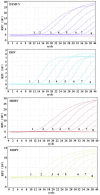One-Step Multiplex Real-Time Fluorescent Quantitative Reverse Transcription PCR for Simultaneous Detection of Four Waterfowl Viruses
- PMID: 39770626
- PMCID: PMC11679685
- DOI: 10.3390/microorganisms12122423
One-Step Multiplex Real-Time Fluorescent Quantitative Reverse Transcription PCR for Simultaneous Detection of Four Waterfowl Viruses
Abstract
Duck Tembusu virus (DTMUV), duck hepatitis virus (DHV), Muscovy duck reovirus (MDRV), and Muscovy duck parvovirus (MDPV) represent four emergent infectious diseases impacting waterfowl, which can be challenging to differentiate due to overlapping clinical signs. In response to this, we have developed a one-step multiplex real-time fluorescence quantitative reverse transcription PCR (qRT-PCR) assay, capable of simultaneously detecting DTMUV, DHV, MDRV, and MDPV. This method exhibits high specificity, avoiding cross-reactivity with other viruses such as Fowl adenoviruses (FADV), infectious bursal disease virus (IBDV), infectious bronchitis virus (IBV), infectious laryngotracheitis virus (ILTV), Haemophilus paragallinarum (Hpg), duck circovirus (DUCV), goose astrovirus (GoAstV), and mycoplasma gallisepticum (MG). The limit of detection (LOD) established for DTMUV, DHV, MDRV, and MDPV was determined to be 27 copies/μL. In the repeatability test, the intra-assay and inter-assay coefficients of variation (CVs) of the recombinant plasmid standard were less than 2%. Utilizing this method, we analyzed 326 clinical specimens sourced from Guangxi over the period spanning October 2021 through December 2023, yielding promising and precise outcomes. The qRT-PCR method established herein exhibits commendable specificity, sensitivity, and repeatability. Furthermore, it boasts a high clinical detection rate, making it a highly effective tool for diagnosing these pathogenic agents in waterfowl.
Keywords: Muscovy duck parvovirus; Muscovy duck reovirus; duck Tembusu virus; duck hepatitis virus; real-time fluorescent quantitative reverse transcription PCR.
Conflict of interest statement
The authors declare no conflicts of interest.
Figures



Similar articles
-
Development and application of a multiplex qPCR assay for the detection of duck circovirus, duck Tembusu virus, Muscovy duck reovirus, and new duck reovirus.Virus Genes. 2023 Feb;59(1):91-99. doi: 10.1007/s11262-022-01946-0. Epub 2022 Oct 18. Virus Genes. 2023. PMID: 36258144
-
Development and application of quadruplex real time quantitative PCR method for differentiation of Muscovy duck parvovirus, Goose parvovirus, Duck circovirus, and Duck adenovirus 3.Front Cell Infect Microbiol. 2024 Aug 19;14:1448480. doi: 10.3389/fcimb.2024.1448480. eCollection 2024. Front Cell Infect Microbiol. 2024. PMID: 39224701 Free PMC article.
-
GeXP analyzer-based multiplex reverse-transcription PCR assay for the simultaneous detection and differentiation of eleven duck viruses.BMC Microbiol. 2015 Oct 30;15:247. doi: 10.1186/s12866-015-0590-6. BMC Microbiol. 2015. PMID: 26518004 Free PMC article.
-
Multiplex digital PCR: a superior technique to qPCR for the simultaneous detection of duck Tembusu virus, duck circovirus, and new duck reovirus.Front Vet Sci. 2023 Aug 10;10:1222789. doi: 10.3389/fvets.2023.1222789. eCollection 2023. Front Vet Sci. 2023. PMID: 37662994 Free PMC article.
-
Development and application of a multiplex PCR method for simultaneous detection of waterfowl parvovirus, duck enteritis virus and goose astrovirus.3 Biotech. 2022 Sep;12(9):205. doi: 10.1007/s13205-022-03238-8. Epub 2022 Aug 3. 3 Biotech. 2022. PMID: 35935544 Free PMC article.
References
Grants and funding
LinkOut - more resources
Full Text Sources

